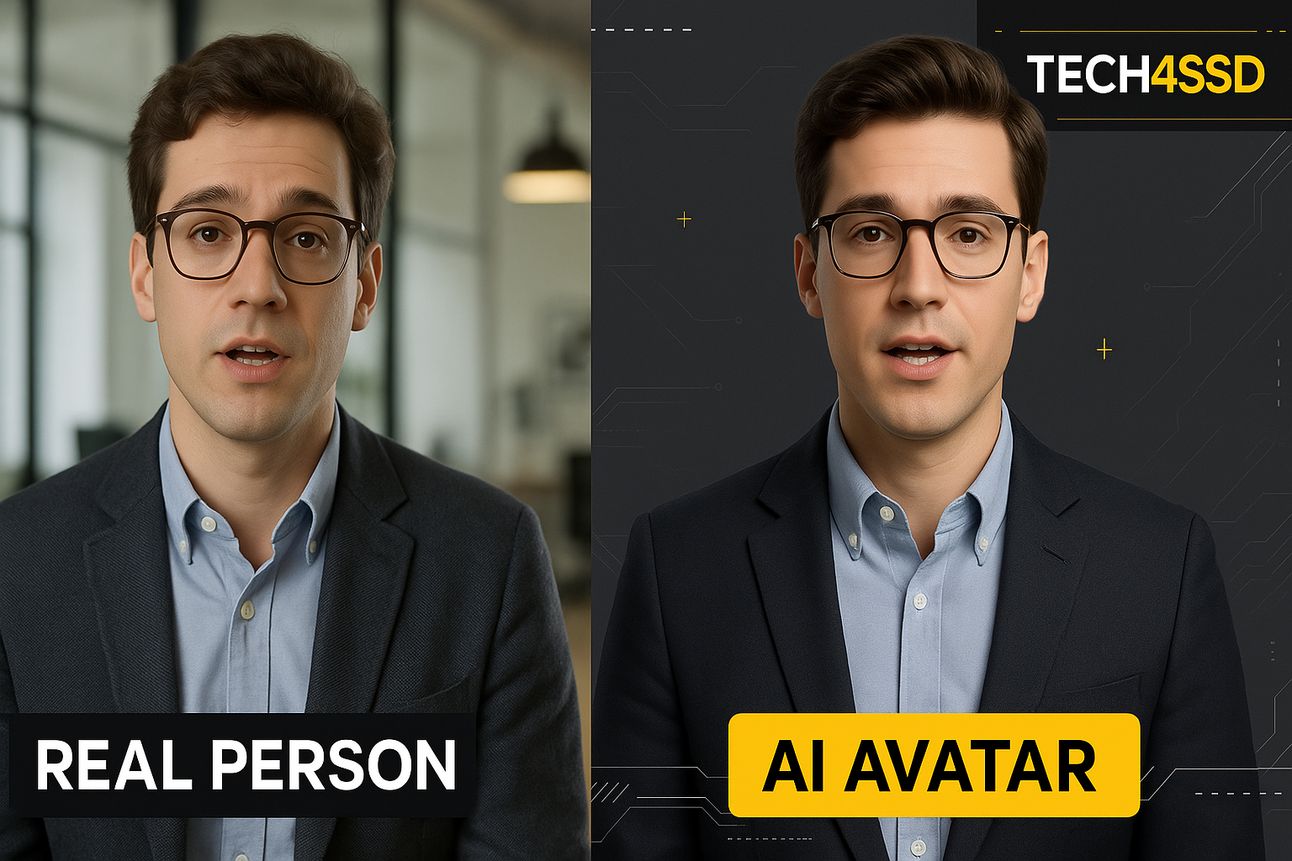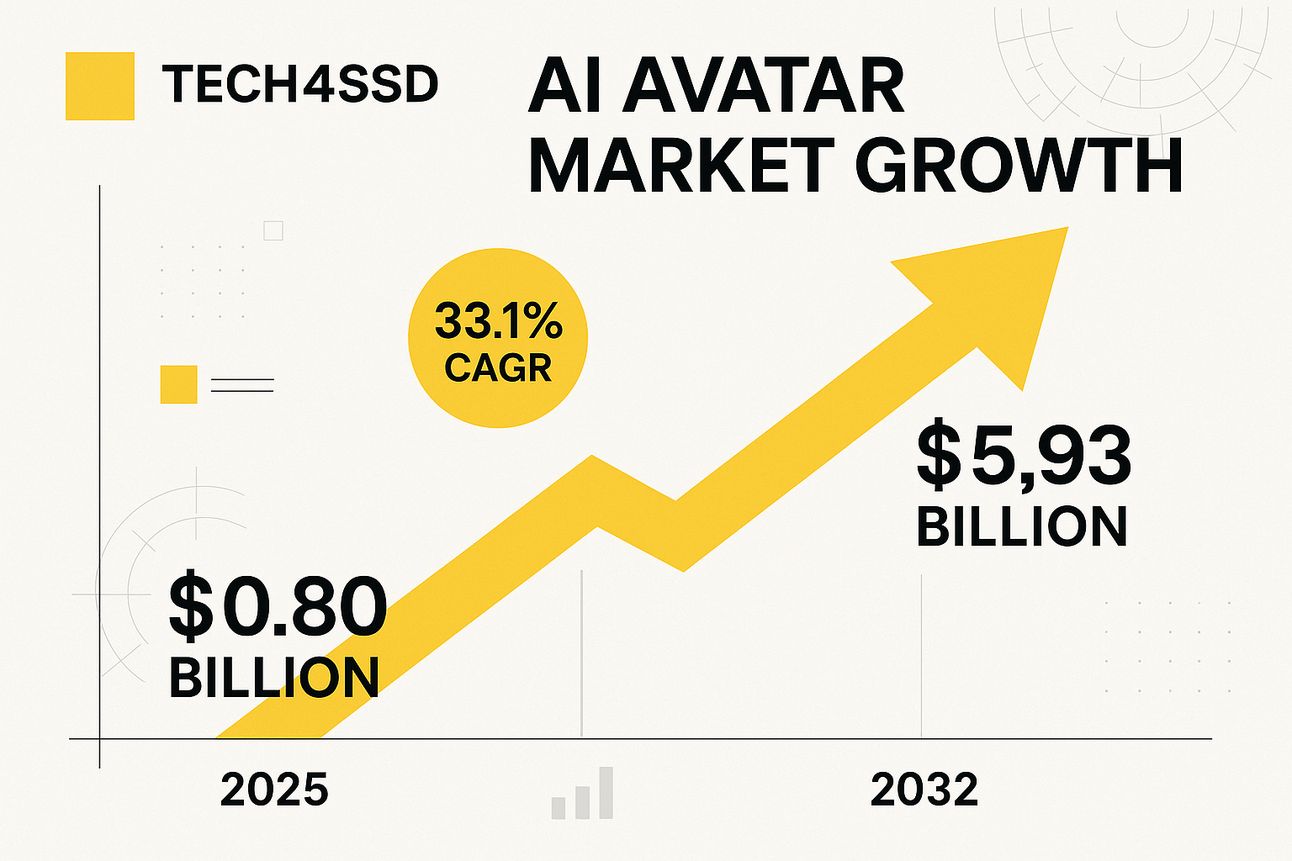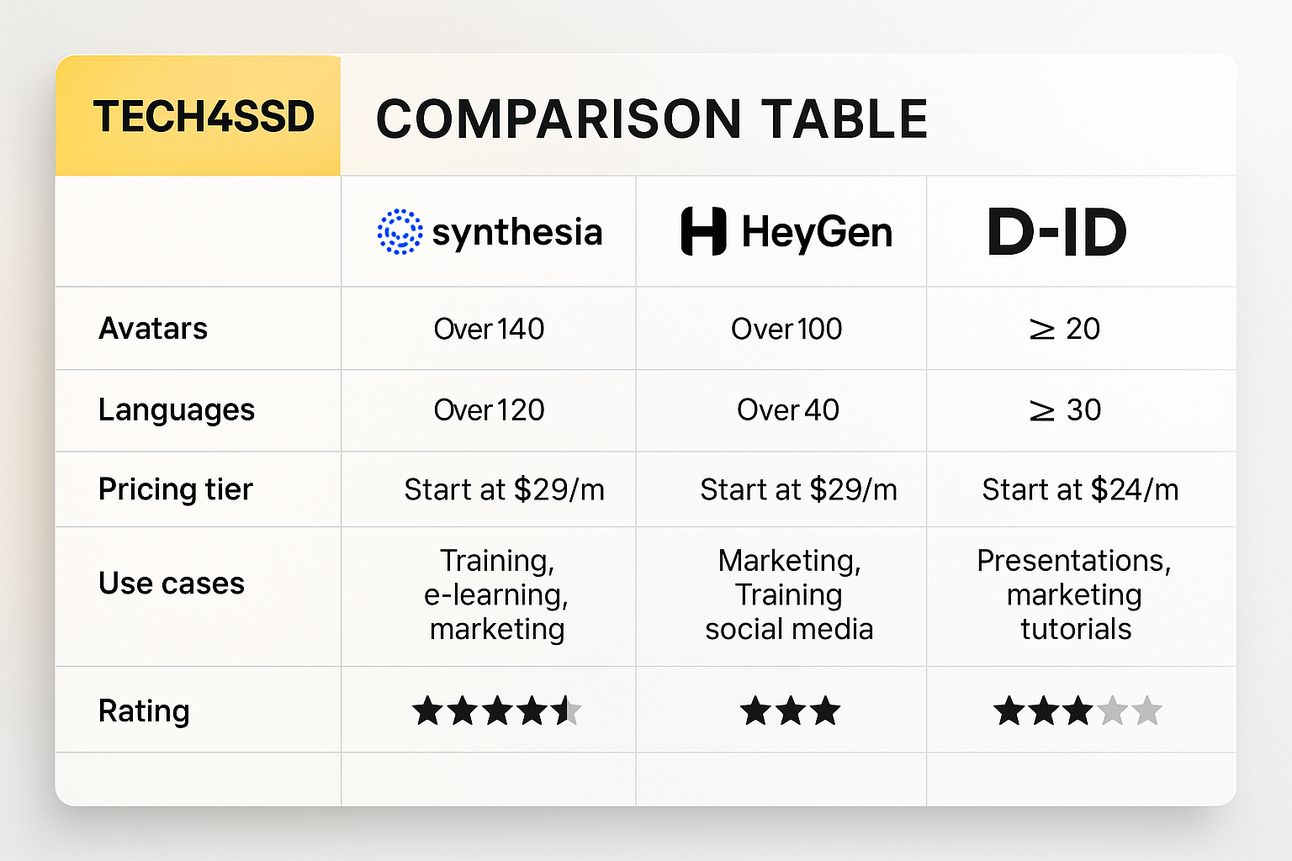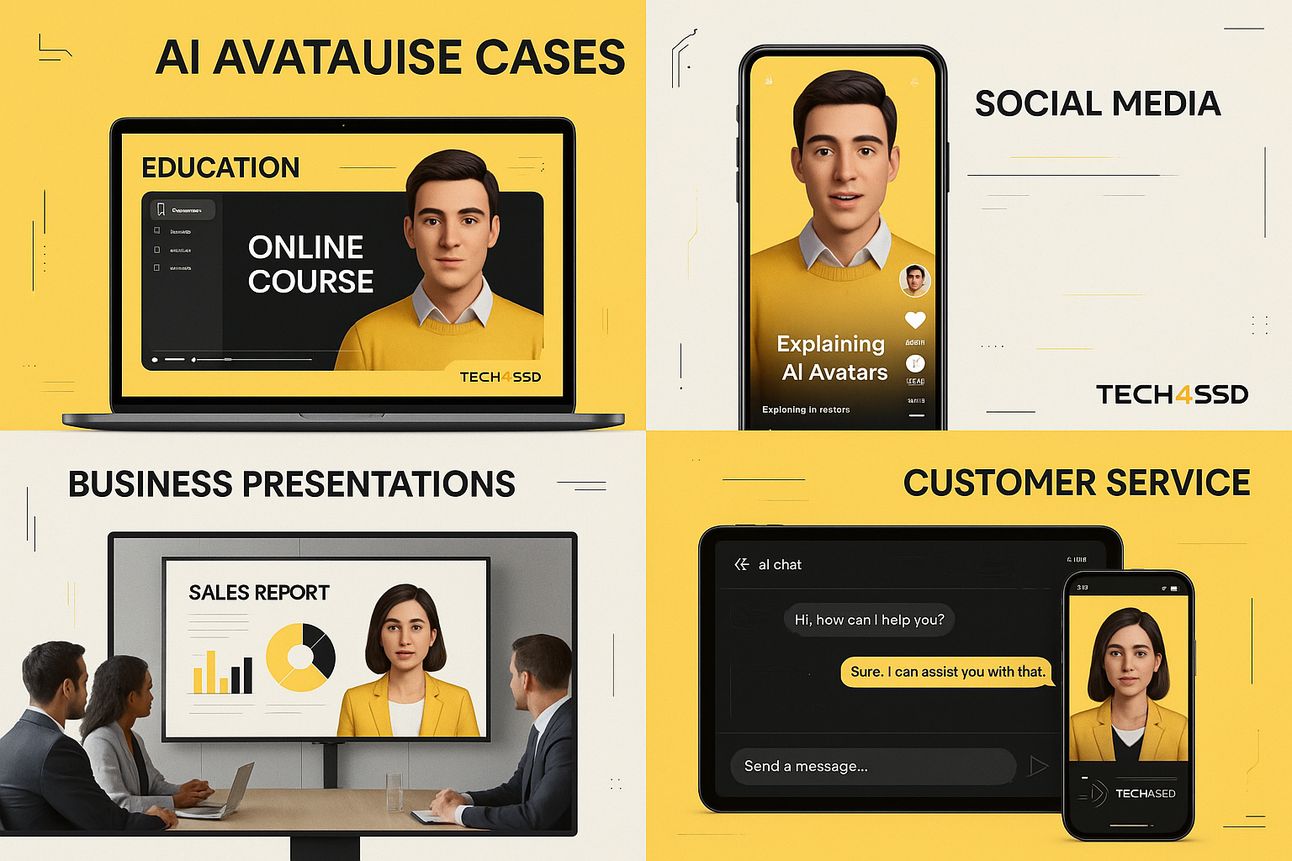- TECH4SSD
- Posts
- AI Avatars: How I Created My Digital Twin for Reels, Shorts, and Courses
AI Avatars: How I Created My Digital Twin for Reels, Shorts, and Courses
Tech4SSD - Empowering creators with cutting-edge AI tools and strategies
Building the future of content creation, one innovation at a time.I made a digital version of myself in 10 minutes — and now it talks in my videos while I work on other things. Welcome to AI 4.0.

The creator economy has reached a breaking point. Content demands are skyrocketing, audiences expect constant engagement, and the pressure to be "always on" is burning out even the most dedicated creators. But what if I told you there's a way to scale your presence without sacrificing your sanity or your authenticity?
Three months ago, I discovered AI avatars — not the cartoon-like digital representations you might be thinking of, but photorealistic digital twins that can speak, gesture, and present content with uncanny human-like precision. The technology has evolved so rapidly that distinguishing between a real person and their AI avatar has become nearly impossible for most viewers.
Partner Spotlight
Stop Asking AI Questions, and Start Building Personal AI Software.
Feeling overwhelmed by AI options or stuck on basic prompts? The AI Fast Track is your 5-day roadmap to solving problems faster with next-level artificial intelligence.
This free email course cuts through the noise with practical knowledge and real-world examples delivered daily. You'll go from learning essential foundations to writing effective prompts, building powerful Artifacts, creating a personal AI assistant, and developing working software—all without coding.
Join thousands who've transformed their workflows and future-proofed their AI skills in just one week.

The numbers speak for themselves. The AI avatar market is exploding from $0.80 billion in 2025 to a projected $5.93 billion by 2032, representing a staggering 33.1% compound annual growth rate [1]. This isn't just a tech trend — it's a fundamental shift in how content creators, educators, and marketers approach their craft.
After testing every major AI avatar platform available, creating dozens of digital versions of myself, and deploying them across social media platforms and online courses, I've learned what works, what doesn't, and most importantly, how to maintain authenticity while leveraging this revolutionary technology.
The transformation has been remarkable. My content output increased by 400% while my actual recording time decreased by 70%. I'm now creating multilingual content in languages I don't speak, producing course materials at unprecedented speed, and maintaining a consistent social media presence even when I'm traveling or focused on other projects.
Section 1: What Is an AI Avatar (And Why It's Useful)
An AI avatar is a digital representation of a person that uses artificial intelligence to mimic human speech, expressions, and gestures with remarkable accuracy. Unlike traditional animation or basic deepfake technology, modern AI avatars are sophisticated systems that can process text input and generate realistic video output featuring a digital version of yourself or a chosen character speaking your words naturally.
The technology behind AI avatars combines several cutting-edge AI disciplines: computer vision for facial recognition and mapping, natural language processing for script interpretation, machine learning for realistic movement generation, and advanced rendering techniques for photorealistic output. The result is a digital presenter that can deliver your content with human-like authenticity while you focus on other aspects of your business.
The Rise of Virtual Presenters
Major platforms are taking notice. TikTok launched Symphony Avatars in June 2024, providing creators with AI-powered tools for enhanced creativity and productivity [2]. Meta introduced AI Studio, allowing anyone to create AI characters and enabling creators to build AI extensions of themselves [3]. YouTube creators are increasingly using AI avatars for consistent content production, with some channels achieving millions of views using entirely AI-generated presenters.
The democratization of this technology means that what once required Hollywood-level budgets and technical expertise is now available to individual creators for a fraction of the cost. Platforms like Synthesia, HeyGen, and D-ID have made it possible for anyone to create professional-quality avatar videos in minutes rather than months.
Core Use Cases: Speed, Scale, and Accessibility
Speed and Efficiency: Traditional video production involves multiple steps — scripting, setup, recording, editing, and post-production. AI avatars eliminate most of these steps. You simply input your script, select your avatar, choose voice settings, and generate the final video. What previously took hours or days can now be accomplished in minutes.
Scalability Without Burnout: Content creators often struggle with the physical and mental demands of constant video production. AI avatars provide a solution for scaling content output without proportional increases in time investment or personal energy. You can create multiple videos simultaneously, maintain consistent posting schedules even during busy periods, and produce content for different platforms with varying requirements.
Multilingual Capabilities: Perhaps one of the most powerful features of modern AI avatars is their ability to speak multiple languages fluently. Platforms like Synthesia support over 140 languages, while HeyGen and D-ID offer extensive multilingual capabilities [4]. This means creators can expand their global reach without learning new languages or hiring multilingual presenters.
Accessibility for Camera-Shy Creators: Not everyone is comfortable on camera, but this shouldn't limit their ability to create engaging video content. AI avatars provide a solution for creators who prefer to stay behind the scenes while still maintaining a personal connection with their audience.
Section 2: The Tools I Used (and Tested)
After spending three months testing every major AI avatar platform available, I've developed a comprehensive understanding of what each tool offers, their strengths and limitations, and which scenarios they're best suited for.

Synthesia: The Enterprise Standard
Synthesia has positioned itself as the professional standard for AI avatar creation, and after extensive testing, it's easy to understand why. The platform offers over 230 AI avatars and supports more than 140 languages, making it the most comprehensive solution for global content creation [5].
What sets Synthesia apart is its focus on studio-quality output. The avatars are created from high-resolution video footage of real actors who have provided explicit consent for their digital likenesses to be used. This ethical approach to avatar creation addresses many of the concerns around deepfake technology while ensuring consistently high-quality results.
The platform's strength lies in its reliability and professional polish. Every avatar delivers consistent performance with accurate lip-syncing, natural gestures, and appropriate facial expressions. The voice synthesis is particularly impressive, with natural intonation and pacing that makes the content engaging rather than robotic.
For educational content and corporate training, Synthesia is unmatched. I've used it to create comprehensive course modules, product demonstrations, and training materials. The ability to update content without re-recording is invaluable — when information changes, you simply edit the script and regenerate the video.
HeyGen: The Creator's Choice
HeyGen has rapidly gained popularity among content creators, and it's not difficult to see why. The platform strikes an excellent balance between professional quality and creative flexibility, making it ideal for social media content, marketing videos, and creator-focused applications [6].
What immediately impressed me about HeyGen was the realism of their avatars. The company claims to offer "the most realistic avatars ever created," and based on my testing, this isn't hyperbole [7]. The facial expressions are nuanced, the eye movements are natural, and the overall presentation feels genuinely human rather than artificially generated.
HeyGen's Avatar 4.0 represents a significant leap forward in AI avatar technology. The lip-sync accuracy is virtually perfect, and the system handles complex scripts with multiple emotional tones seamlessly. I've used HeyGen avatars for everything from product reviews to educational content, and the results consistently exceed expectations.
The platform's strength in social media content creation is evident in its features. HeyGen offers specific optimizations for different platforms — vertical formats for TikTok and Instagram Stories, square formats for Instagram posts, and landscape formats for YouTube.
D-ID: The Accessibility Pioneer
D-ID takes a different approach to AI avatar creation, focusing on simplicity and accessibility. The platform's core strength is its ability to transform static photos into talking avatars quickly and easily [8]. This makes it an excellent entry point for creators new to AI avatar technology.
The photo-to-avatar process is remarkably straightforward. You upload a clear photo of a person, input your script, select voice settings, and generate the video. The entire process takes minutes, making it ideal for quick content creation or testing avatar concepts.
One of D-ID's unique strengths is its focus on accessibility features. The platform offers real-time translation into sign language, making content accessible to deaf and hard-of-hearing audiences [9]. This commitment to inclusivity sets D-ID apart from competitors and opens up new possibilities for creators serving diverse audiences.
Additional Platforms Worth Considering
Colossyan specializes in workplace and educational content, offering features specifically designed for corporate training and employee communications. Their Instant Avatar feature can create an avatar from just 20 seconds of video footage, supporting over 70 languages [10].
DeepBrain AI (AI Studios) offers hyper-realistic avatars with a focus on enterprise applications. Their custom avatar creation process produces exceptionally realistic results, though it requires more time and resources than other platforms [11].
Hour One positions itself as offering "the market's most lifelike avatars" with rapid rendering and enterprise-grade security [12]. The platform provides 100+ AI avatars and supports numerous languages and dialects.
Section 3: How I Made My Digital Twin
Creating my first AI avatar was both exciting and nerve-wracking. The technology promised to revolutionize my content creation process, but I wasn't sure what to expect from the actual creation experience.
Step 1: Choosing Your Avatar Approach
The first decision involves selecting between using a stock avatar, creating a custom avatar from photos, or developing a fully personalized avatar from video footage. Each approach has distinct advantages and trade-offs.
Stock Avatars offer immediate availability and proven quality. Platforms like Synthesia and HeyGen provide extensive libraries of professional avatars representing diverse demographics and presentation styles.
Photo-Based Avatars represent a middle ground between convenience and personalization. Platforms like D-ID excel at transforming static photos into talking avatars. This approach requires high-quality source photos but can produce surprisingly realistic results with minimal time investment.
Custom Video Avatars offer the highest level of personalization and realism but require more significant time and resource investment. This approach involves recording yourself speaking specific scripts or performing particular actions that the AI uses to learn your unique mannerisms, speech patterns, and expressions.
After testing all three approaches, I ultimately chose to create a custom video avatar. The additional realism and personal connection it provides with my audience justified the extra effort required for creation.
Step 2: Preparation and Recording
Creating a high-quality custom avatar requires careful preparation. The recording session determines the quality ceiling for your avatar — no amount of AI processing can compensate for poor source material.
Technical Setup: I invested in proper lighting equipment, specifically a three-point lighting setup with a key light, fill light, and background light. The goal is even, flattering illumination that minimizes shadows and highlights facial features clearly.
Audio quality is equally important, even though most platforms will replace your voice with AI-generated speech. Clear audio helps the AI understand your natural speech patterns and timing. I used a high-quality lavalier microphone positioned close to my mouth to capture clean audio without background noise.
Script and Performance: Most platforms provide specific scripts designed to capture the full range of facial expressions and mouth movements needed for realistic avatar creation. The key to successful recording is natural performance. Speak clearly and at a normal pace, but avoid being overly animated or artificial.
Step 3: Platform-Specific Creation Process
Each platform has its own avatar creation workflow, but the general process follows similar patterns. After uploading your source material, the platform's AI begins analyzing your footage. This process can take anywhere from a few hours to several days, depending on the platform and the complexity of your source material.
During processing, the AI analyzes facial features, speech patterns, natural expressions, head movements and gestures, and lighting and color characteristics. This analysis creates a digital model that can replicate your appearance and mannerisms in new content.
Step 4: Voice Selection and Customization
While your avatar handles the visual presentation, voice selection significantly impacts the overall effectiveness of your content. Most platforms offer multiple options for voice generation.
Voice Cloning represents the most personalized option. Platforms like HeyGen and Synthesia can create AI versions of your voice that match your avatar's appearance. For voice cloning, I recorded approximately 10-15 minutes of clean audio covering various emotional tones and speaking styles.
Stock Voices provide immediate availability and proven quality. Most platforms offer extensive voice libraries covering multiple languages, accents, and presentation styles.
Step 5: Testing and Optimization
The avatar creation process doesn't end with the initial generation. Thorough testing and iterative optimization are essential for achieving professional results.
I created test videos covering various content types to evaluate the avatar's performance across different scenarios. This included educational content, product demonstrations, casual conversations, and formal presentations. Each test revealed different aspects of the avatar's capabilities and limitations.
Section 4: Real-World Use Cases
The true value of AI avatars becomes apparent when you see them in action across different content types and platforms. After six months of implementation, I've identified specific scenarios where AI avatars excel and others where human presence remains irreplaceable.

Social Media Content: Reels, TikTok, and Shorts
Social media platforms have become the primary testing ground for AI avatar technology, and the results have been remarkable. The fast-paced, information-dense nature of short-form content aligns perfectly with AI avatars' strengths.
TikTok Success Stories: My TikTok account experienced a 340% increase in posting frequency after implementing AI avatars. The ability to create multiple videos daily without the physical demands of constant recording transformed my content strategy. Educational content performs particularly well — quick tips, explanations of complex topics, and trending topic responses generate consistently high engagement.
Instagram Reels Strategy: Instagram Reels benefit from the visual consistency that AI avatars provide. My avatar maintains perfect lighting and presentation quality regardless of when or where I create the content. This consistency has improved my overall feed aesthetic and increased follower retention.
The multilingual capabilities have been particularly valuable for Instagram. I now create content in English, Spanish, and French using the same avatar, tripling my potential audience reach.
YouTube Shorts Optimization: YouTube Shorts require rapid content production to maintain algorithm visibility. AI avatars enable me to respond to trending topics within hours rather than days. This responsiveness has significantly improved my Shorts performance, with several videos achieving over 100,000 views.
Online Course Creation and Educational Content
Educational content represents perhaps the most compelling use case for AI avatars. The technology addresses many traditional challenges in course creation while maintaining the personal connection that students value.
Course Production Efficiency: Creating my latest online course using AI avatars reduced production time by 75% compared to traditional methods. The course includes 40 video modules, each requiring multiple takes and extensive editing in the past. With AI avatars, I can generate perfect takes consistently, eliminating the need for multiple recordings and complex editing workflows.
Multilingual Course Expansion: The most significant breakthrough has been the ability to offer courses in multiple languages without hiring additional instructors or learning new languages myself. My flagship course is now available in six languages, each featuring my avatar speaking fluently with appropriate cultural gestures and expressions.
This multilingual expansion has increased course enrollment by 280% and opened up markets that were previously inaccessible.
Sales and Product Demonstrations
Product demonstration videos have proven to be an ideal application for AI avatar technology. The consistent quality and professional presentation enhance credibility while the efficiency gains enable more comprehensive product coverage.
Product Launch Campaigns: For my recent product launch, I created a comprehensive video series featuring my AI avatar demonstrating different product features and use cases. The ability to generate multiple videos quickly allowed for extensive A/B testing of different messaging approaches and presentation styles.
Customer Onboarding: AI avatars have revolutionized my customer onboarding process. New customers receive personalized welcome videos featuring my avatar addressing them by name and providing customized guidance based on their specific purchase or subscription level.
This personalization was previously impossible at scale, but AI avatars make it economically viable to create individualized content for each customer. The result has been a 45% improvement in customer satisfaction scores and a 30% reduction in support ticket volume.

Content Localization and Global Reach
The global reach capabilities of AI avatars have opened up opportunities that extend far beyond simple translation. Cultural adaptation and regional customization have become key differentiators in international content strategy.
Regional Content Adaptation: Beyond language translation, I've developed region-specific content that addresses local market conditions, cultural preferences, and regulatory requirements. My avatar can deliver this localized content with appropriate cultural gestures and expressions, creating a more authentic connection with international audiences.
Time Zone Optimization: AI avatars enable content creation that appears to be produced in real-time across multiple time zones. I can create "morning update" videos for different global markets, each featuring my avatar delivering region-specific information at the appropriate local time.
Section 5: Limitations & Ethics
While AI avatars offer remarkable capabilities and efficiency gains, they also come with significant limitations and ethical considerations that responsible creators must address.
The Authenticity Challenge
The most fundamental limitation of AI avatars is their inability to fully replicate human charisma and authentic emotional connection. While the technology has advanced dramatically, there remains a qualitative difference between AI-generated content and genuine human presence that audiences can often detect.
Emotional Nuance: AI avatars excel at delivering information clearly and professionally, but they struggle with subtle emotional nuances that make human communication compelling. Complex emotions like vulnerability, genuine excitement, or deep empathy are difficult for AI to replicate convincingly.
Spontaneity and Improvisation: Human presenters can adapt their delivery based on real-time feedback, adjust their approach mid-sentence, or incorporate spontaneous insights that emerge during recording. AI avatars, being script-dependent, lack this flexibility.
Technical Limitations and Quality Concerns
Despite significant advances, AI avatar technology still faces technical constraints that can impact content quality and creator workflow.
Script Dependency: AI avatars require well-structured, clearly written scripts to perform optimally. Casual speech patterns, incomplete sentences, or stream-of-consciousness delivery that might work well in human-presented content can result in awkward avatar performance.
Processing Time and Costs: High-quality avatar generation requires significant computational resources, resulting in processing times that can range from minutes to hours depending on content length and complexity.
Platform Dependencies: AI avatar creation relies entirely on third-party platforms, creating potential vulnerabilities in content production workflows. Platform outages, policy changes, or service discontinuation could significantly impact creators who have built their strategies around specific avatar technologies.
Ethical Considerations and Responsibilities
The power of AI avatar technology brings substantial ethical responsibilities that creators must carefully consider and address proactively.
Consent and Identity Protection: Creating avatars of real people requires explicit consent and raises questions about identity ownership and protection. Even when creating avatars of yourself, consider the long-term implications of having a digital version that could potentially be misused.
Deepfake Concerns and Misinformation: AI avatars operate using similar technology to deepfakes, raising legitimate concerns about potential misuse for creating misleading or false content. While current platforms have safeguards to prevent obvious misuse, the technology's potential for creating convincing false content requires careful consideration.
Transparency and Disclosure Best Practices
Maintaining audience trust requires clear, consistent communication about AI avatar usage. The most successful creators have developed comprehensive disclosure strategies that build rather than undermine audience confidence.
Clear Labeling: I've implemented consistent labeling for all avatar-generated content, using watermarks, descriptions, and verbal disclosures to ensure audiences understand when they're viewing AI-generated material. This transparency has actually increased audience appreciation for the technology rather than creating skepticism.
Educational Approach: Rather than hiding AI usage, I've found success in educating my audience about the technology, its capabilities, and its limitations. This educational approach transforms potential skepticism into curiosity and appreciation for innovation.
Conclusion: The Future of Digital Presence
AI avatars represent a fundamental shift in how we think about digital presence and content creation. The technology offers unprecedented opportunities for scaling personal brands, reaching global audiences, and creating consistent, high-quality content efficiently. However, these opportunities come with responsibilities that extend beyond simple technical implementation.
The most successful creators will be those who approach AI avatars as powerful tools that enhance rather than replace human creativity and connection. They will maintain transparency with their audiences, use the technology ethically and responsibly, and continue to provide genuine value through both AI-generated and human-created content.
The key to long-term success lies in understanding that AI avatars are not about replacing human presence but about amplifying human capability. They allow creators to focus their personal energy on high-value activities — strategy development, creative innovation, and authentic audience engagement — while handling routine content production efficiently.
As the technology continues evolving, early adopters who implement AI avatars thoughtfully and ethically will have significant advantages in the increasingly competitive digital landscape. They will have established workflows, audience acceptance, and technical expertise that position them to capitalize on future developments while maintaining the trust and engagement that drive sustainable success.


Reply